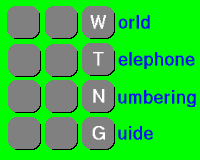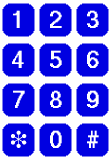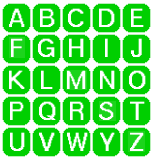


 Main Page
Main Page
 Calendar
Calendar
 Glossary
Glossary
 History
History
 Regional Services
Regional Services
 Special Services
Special Services
 What's New
What's New

|
|
|
| Updated 5 January 2013 | By Country Code | By Country Name | Other WTNG pages | Acknowledgements | ||

|

|

|
 Main Page
Main Page
 Calendar
Calendar
 Glossary
Glossary
 History
History
 Regional Services
Regional Services
 Special Services
Special Services
 What's New
What's New
|
|
||
|
|
Canada | +1 | ||||
Area Code: 3 digits Subscriber Number: 7 digits Trunk Prefix: 1 (0 for special calls) International Prefix: 011 (01 for special calls)
Area code assignments and the overall operation of the numbering and dialling plans are ultimately administered by the NANP Administrator.
Local calls within +1 819 already require 10-digit dialing, including the area code. Therefore, no further dialling changes are required to introduce +1 873 numbers.
Sources:
NANPA Planning Letter PL-405 (25 June 2010)
Local calls within +1 819 already require 10-digit dialing, including the area code. Therefore, no further dialling changes are required to introduce +1 873 numbers.
Local calls within this territory already require 10-digit dialing, including the area code. Therefore, no further dialling changes are required to introduce +1 365 numbers.
Sources:
CRTC Telecom Decision 2010-213, 13 April 2010.
Prior to this, local calls within Manitoba will require 10-digit dialing, including the area code. From 29 July 2012, calls placed in the existing 7-digit format will be completed in a permissive mode after callers receive a recorded announcement advising to use 10-digit dialling. 10-digit local dialling becomes mandatory 3 November 2012.
Sources:
NANPA Planning Letter PL-435 (23 February 2012) (update of PL-433)
NANPA Planning Letter PL-419 (6 May 2011)
Sources:
Sources: Telecommunications Alliance press release (29 September 2009)
613/343 and 450/579 overlay information (Telecommunications Alliance)
(with tip courtesy Nigel Allen)
Central office codes 468, 568, 579, 871, and 873 (the three digits following +1 613) are protected from assignment within +1 613 since these are possible future area codes. Central office code 343 (+1 613 343) will also be protected and not assigned, as it is the new overlay area code. Additionally, central office codes 365, 367, 428, 431, 437, 460, 672, 753, 879, and 942 will be protected within +1 613 until the new +1 343 code takes effect, but these could be assigned beforehand as a last resort if the extra numbering capacity is required.
Timeline:
TBD: Test numbers +1 343 xxx xxxx in service.
17 May 2010: New +1 343 numbers may enter into service in the existing +1 613 (Ottawa/eastern Ontario) territory.
Sources: Telecom Decision CRTC 2008-89 (10 September 2008)
613/343 and 450/579 overlay information (Telecommunications Alliance)
Timeline (coordinated with British Columbia area code changes):
22 April 2008: Test numbers +1 587 N10 xxxx in service.
22 June 2008: Date by which carriers should be capable of processing calls into +1 587.
23-27 June 2008: Recorded announcement advises subscribers in +1 403 and +1 780 that they should now dial 10 digits for local calls if the subscriber continues to dial their local calls as just 7 digits. 7-digit dialled calls would still completes after the recorded announcement.
8-12 September 2008: 10-digit local calling now mandatory within +1 403 and +1 780.
19 September 2008: New +1 587 numbers may enter into service.
+1 825 was also reserved as a future Alberta area code.
Cross-border local calling with Alberta exists in Saskatchewan at Lloydminster and Marshall, and in Montana at Sweetgrass. Any 7-digit local call arrangements into Alberta from these places should not be immediately affected by the introduction of +1 587.
Sources:
NANPA Planning Letter PL-374 (PDF, 26 February 2008)
CRTC Telecom Decision 2007-42 (14 June 2007)
NANPA Planning Letter PL-369 (PDF, 15 October 2007).
(additional input courtesy Mark Cuccia, markjcuccia@yahoo.com)
Timeline (proposed, subject to final CRTC/CNAC decisions):
21 April 2008: Test numbers in +1 581 610 xxxx in service.
21-27 June 2008: Recorded announcement advises subscribers in +1 418 that they should now dial 10 digits for local calls if the subscriber continues to dial their local calls as just 7 digits. 7-digit dialled calls would still completes after the recorded announcement.
6-12 September 2008: 10-digit dialling of local calls within +1 418 becomes mandatory.
19 September 2008: +1 581 numbers may enter into service.
Some local calling arrangements among Campbellton, New Brunswick (+1 506) and Labrador City-Wabush, Newfoundland and Labrador (+1 709) and adjacent Quebec +1 418 exchanges are expected to continue with 7-digit access.
Sources:
NANPA Planning Letter PL-373R1 (PDF, 12 February 2008).
CNAC Draft NPA 418 Planning Letter (13 July 2007)
(report courtesy Mark J. Cuccia)
The province-wide overlay of +1 778 affects existing British Columbia regions as follows:
Inner Vancouver: This area was an overlay of +1 604 and +1 778 and that situation will remain unchanged.
Lower Mainland/Outer Vancouver: Numbers in this area were previously only area code +1 604; new +1 778 numbers will overlay this area.
Remainder of British Columbia: +1 250 numbers will be overlaid with new +1 778 numbers. The existing regime of 7-digit local calling will be replaced by mandatory 10-digit dialling.
Timeline:
7 June 2007: number ranges in +1 778 may be assigned for use throughout British Columbia, but are not to be placed into service until 4 July 2007. Until 10-digit local dialling becomes mandatory in +1 250, central office code number ranges in +1 778 may not conflict with existing +1 250 ranges.
4 July 2007: +1 778 numbers may be activated throughout British Columbia.
23-27 June 2008: Recorded announcement advises subscribers in +1 250 that they should now dial 10 digits for local calls.
8-12 September 2008: 10-digit local calling now mandatory within +1 250.
Also, +1 236 is reserved as a future British Columbia area code, therefore numbers cannot be assigned in +1 250 236, +1 604 236, +1 778 236.
Sources:
CRTC Telecom Decision 2007-38 (7 June 2007)
NANPA Planning Letter PL-361 (22 June 2007, PDF)
(report courtesy Mark J. Cuccia)
(reports courtesy Mark J. Cuccia)
All local calls will require 10-digit dialling (area code plus subscriber number, without long distance prefix). Currently, the 7-digit subscriber number is sufficient for calls within +1 514. The 10-digit dialling will become mandatory between 24 September 2005 and 1 October 2005. Numbers in +1 438 will be introduced some time after that.
Prior to this, a permissive local dialing approach would be introduced by 17 June 2006 and 24 June 2006, where local calls within +1 514 could continue to be dialled as 7 digits or 10 digits, but that recorded messages may warn of the introduction of mandatory 10-digit dialling.
Callers in +1 450 will also be required to dial local calls as 10 digits at the same time as Montreal Island.
The dates of the introduction of mandatory 10-digit local dialling and the new area code were postponed several times:
A four-month permissive dialling period begins 17 June 2006, prior to mandatory 10-digit local calling. On this date, calls using the 7-digit format will first receive a warning recording about the introduction of 10-digit dialling, followed by completion of the call.
Test numbers in new area code +1 226 will be activated on 15 April 2006. International carriers should be providing access to +1 226 by 17 June 2006.
For details of the decision to overlay +1 519 see Telecom Decision CRTC 2002-25 of 22 April 2002. Also see reference 8698-C12-17/01.
Traditionally, local calling between +1 519 and adjacent area codes required only the 7-digit number, and not the 10-digit format. However, as of 16 November 2002, calls from +1 519 numbers to area code +1 905 (and now +1 289) require 10-digit dialling. As of the introduction of the new area code overlay for +1 519, local calls from +1 519 to other area codes will also require 10-digit dialling, and vice versa. Reference for +1 905/+1 289 case: Order CRTC 2001-840 of 22 November 2001.
Originally, it was expected that existing area code +1 519 capacity would be exhaused around the second quarter of 2006. A working group was set up February 2001 towards a plan for new area codes to be assigned in this region.
The introduction of +1 226 was postponed from an original goal of early 2005.
References:
A permissive period would begin 17 June 2006 where calls placed in 7-digit format would receive a warning recording about the introduction of 10-digit dialling. The call would still be completed during the permissive period until 21 October 2006.
The rationale for this change involves the nature of local calling in the National Capital Region. Local calling without long distance charges has long existed between the Ottawa (Ontario +1 613) and Hull-Gatineau (Quebec +1 819) communities. Many central office or exchange codes in +1 613 were "protected" because assigning these could cause a conflict with exchange codes used to make local calls to Hull-Gatineau +1 819. Likewise, Quebec-side telephone number ranges must be assigned to avoid conflict with Ottawa numbers in the local calling area. The local calling area in this region has also grown significantly to include more exchanges in surrounding communities on both the Ontario and Quebec sides.
The Canadian Numbering Administrator recommended in its 2000 Central Office Code Utilization Survey (COCUS) that new area codes would need to be added in the existing area code +1 613 and +1 819 territories around 2004. CRTC announcements then indicated relief of this area code would be required by 2005-2006.
If the regional practice of number range protection was to be removed, the date at which area code +1 613 would require relief would be postponed until at least 2009.
CRTC Telecom Decision 2003-10, 28 February 2003 announced that 10-digit dialling would be required in the National Capital Region in late 2006. This is postponed from an earlier plan to implement this in late 2004, that is Order CRTC 2001-841 of 28 November 2001.
In the third quarter of 2008, a new area code was expected to be introduced in the area code +1 613 territory, as a distributed overlay. Specific dates and introduction details are to be determined.
The federal government has offices on both the Ontario and Quebec sides of the National Capital Region. Six central office codes are used by the government in a "dual-dialable" mode - that is, a government office number can be reachable using either +1 613 or +1 819 area code. These codes will remain protected, while general subscriber numbers would no longer be protected.
Five government protected number ranges are currently in service:
+1 819 934xxxx, +1 819 953xxxx, +1 819 956xxxx, +1 819 994xxxx, +1 819 997xxxx. The sixth central office code, representing number range +1 819 939xxxx, is reserved for future use.
10-digit dialling will be implemented in areas of +1 613 and +1 819 that are far from the Ottawa-Hull/Gatineau local calling region (for example, Kingston, Ontario and far northern Quebec points). Such areas are not expected to ever have local calling access with the National Capital Region.
See the following:
New +1 778 area numbers will be assigned in Abbotsford, Mission and Vancouver, and not throughout the +1 604 area as it existed in 2000. Other places will remain +1 604 only.
References:
Despite the relatively wide area of the existing +1 905 territory, and limited local calling areas, an overlay was chosen instead of a geographic split.
All local calls would have to be dialled as 10 digits (area code + subscriber number, whether or not the call is placed within the same area code).
At least one party disputed the estimated timing when +1 905 will need a relief area code, particularly given that current forecast dates are much earlier than previously estimates.
References:
This is an overlay to the existing +1 416 area code, where City of Toronto subscribers could be assigned numbers in either +1 416 or +1 647 area codes. 10-digit dialling is now required for all local calls as of 5 March 2001, whether calling to a number in the same area code or not.
A recorded warning message was heard by local callers using the 7-digit format as of 8 January 2001.
An information site on the introduction of the +1 647 overlay code is available from the Add The Code site, sponsored by the major telecom carriers.
This has been announced in various media reports, including the Toronto Star and Angus Telemanagement's Update #154.
Various competing carriers and companies have banded together for the purpose of promoting the +1 416/+1 647 overlay area code plan (see Angus Telemanagement's Update 197 and Update 155.
Further information should be available from CNA.
During proposals to expand numbering capacity in Toronto, an "overlay" in Toronto (a new area code within the existing +1 416 territory) was considered to be an early favourite solution.
At one point in the process, WTNG was told that the overlay would be for both 416 and 905 area codes, but this was obviously modified to a +1 416-only overlay, returning to originally-reported plans.
The known early proposals for a Toronto-only (416) split included:
Information found on NANPA's website in October 1998 indicated that future possible area code assignments for central Ontario included +1 437 (split/overlay for +1 905) and +1 942 (a subsequent +1 416/+1 647 overlay). These assignments are presumed to be preliminary and unofficial. As such these are subject to change or correction.
(Details courtesy Angus Telemanagement, Bell Canada, Mark Cuccia, TELNUM-L list)
The area code boundary line lies along an approximately east-west line, with area code 780 territory north of Red Deer and Stettler.
Telus is the major telecom carrier in Alberta.
See also: Local Calling Guide (including Canadian Exchanges / Local Calling Areas) (courtesy Ray Chow).
Some of the preliminary details were summarised by Mark Cuccia in an article for Telecom Digest vol 16 #522. See back issues section of the TELECOM Digest website.
Other preliminary reports of the 403 split news were courtesy Joey Lindstrom.
Montreal Island plus Ile-Bizard, Ile-Perrot, Ile-des-Soeurs and Ile-Notre-Dame retained +1 514, with all other +1 514 numbers changed to +1 450 area code.
Montreal Island plus Ile-Bizard, Ile-Perrot, Ile-des-Soeurs and Ile-Notre-Dame retained +1 514. All other +1 514 numbers changed to +1 450. +1 450 began service 13 June 1998 for permissive dialling, and was mandatory as of 16 January 1999.
For other pages of +1 514/+1 450 split information, see:
Of the methods of new area code introduction analysed below, the geographically-based split was chosen. Known proposals for a Montreal region (+1 514) split included:
+1 403 was previously used for Yukon and western Northwest Territories points, and was shared with Alberta.
+1 819 was previously used in the eastern Northwest Territories (most of which is now Nunavut), a code that was shared with Quebec.
Permissive dialling of +1 867 or the relevant +1 403 and +1 819 numbers was allowed until 26 April 1998. Only +1 867 was valid for the territories after that time.
References:
In April 1999, the Northwest Territories was split into two political territories, Nunavut in the east and a western territory which retains the Northwest Territories name at this time. No further area code changes are planned to reflect this situation.
(Angus Telemanagement's Update reported the above Toronto, Montreal and Territories developments in various editions in 1996. Toronto/Montreal note was in Update #38, June 1996. Additional confirmation of Territories' situation courtesy Mark J. Cuccia markjcuccia@yahoo.com.)
Area code +1 604 was reduced in territory to an area in the Vancouver region known as the Lower Mainland. Numbers outside the Lower Mainland (including provincial capital Victoria) changed area code to +1 250. +1 250 was in service as of 19 October 1996, becoming mandatory as of 6 April 1997.
+1 250 was activated as of 19 October 1996. It became mandatory for dialling as of 6 April 1997 (advanced from an originally planned 1 June 1997 mandatory date).
+1 610 was changed to +1 600 on 1 October 1993. This allowed the January 1994 introduction of +1 610 as a new area code in the Philadelphia, U.S.A. region (the former +1 215 area code territory there was split).
CNAC should have current information regarding valid assignments of the three digits that follow +1 600.
+1 905 began service for permissive dialling on 4 October 1993, becoming mandatory as of 25 March 1994.
 Return to Top
Return to Top